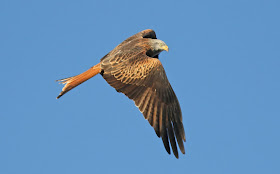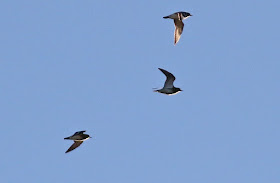Was gutted to not catch up with the American Horned Lark at Staines despite a brief attempt over the weekend and then after managing to book some time off yesterday, the bird decided to do the bunk.
However the Parrot Crossbills at Wishmoor Bottom were some consolation, especially considering we got them on the Surrey side which meant another tick for my Surrey List. Found out recently that I'm in the top ten of Surrey listers (SEE HERE) which was a bit of a surprise.
Great to catch up with Darryl and Greg and also met Polly for the first time. Also bumped into Mush, Mike and Brian from the south west.
Male Parrot Crossbill
Male and female Parrot Crossbill
Immature male Parrot Crossbill, obviously less intense red colouration than adult male.
Male and female Parrot Crossbill. In all the photos the strong bull-necked appearance is apparent. Typically the bill has a strongly decurved culmen (parrot like) with the lower mandible very deep and bulging to the centre. Here's a couple of calls from Dave Lambert HERE and some song HERE. In comparison here are some Common Crossbill calls HERE. Overall the call of Parrot Crossbill is deeper and harder but there is a lot of overlap.
Darryl, Greg and Polly
THAT LARK
American Horned Lark, Staines by Shaun Ferguson . The streaking on the breast is one of the key identification features. Alpestis is also larger, has more rufous upperparts, has a narrow pale ear covert patch, has contrast between the flanks and belly and should have deeper yellow on the face.
So I had to do with internet birding this bird but interesting doing a bit of reading up and the complexity of Horned Lark identification. As far as I can work out this is the latest on the situation ( see Jose Luis Copete's summary here: BIRDING FRONTIERS PIECE) . It looks like a taxonomic revision is underway with the suggested six splits as follows: (In the WP region the main splits would be Shorelark, Atlas Horned Lark and Caucasian Horned Lark with extra-limital American Horned Lark and possibly Steppe Horned Lark):
1. SHORELARK flava, from N Eurasia E to NE Russia (Anadyrland), S to S Norway, L Baikal and NW Amurland
2. AMERICAN HORNED LARK alpestris, for the whole of North America, pending further study, since in that continent there are around 30 different subspecies described, depending of the authorities.
3. ATLAS HORNED LARK atlas, from Atlas Mts in Morocco
Atlas Horned Lark from Morrocco Trip Report HERE. The main id feature is the rich cinnamon coloured nape.
4. CAUCASIAN HORNED LARK penicillata, from E Turkey and Caucasus E to N & W Iran
Caucasian Horned Lark, Georgia
Caucasian Horned Lark, Turkey Trip report HERE. The main identification feature is the obvious connection of the black mask and breast band.
5. STEPPE HORNED LARK brandti, from SE European Russia (lower R Volga) and N Transcaspia E to W Manchuria, S to N Turkmenistan, Tien Shan and Mongolia
6. 'HIMALAYAN HORNED LARK' elwesi, from S & E of Tibetan Plateau
Just to indicate the complexity of the situation here are the sub-species that HBW ALive currently recognise:
6. 'HIMALAYAN HORNED LARK' elwesi, from S & E of Tibetan Plateau
Just to indicate the complexity of the situation here are the sub-species that HBW ALive currently recognise:
Subspecies and Distribution
· E. a. arcticola (Oberholser, 1902) – Alaska and NW Canada
(Yukon S to British Columbia); winters in W USA.
· E. a. hoyti (Bishop,
1896) – N Canada (N Baffin I S to N Alberta and W Ontario); winters in N USA.
· E. a. alpestris (Linnaeus, 1758) – American Horned Lark –
E Canada (W Ontario E to Newfoundland and S to Nova Scotia) and E USA (E from
Minnesota and S to Kansas and N Carolina); N populations winter in E USA.
· E. a. strigata (Henshaw, 1884) – W & WC Canada and USA
(British Columbia S to N California and E to Idaho, Nevada and Utah); N
populations winter in W USA.
· E. a. leucolaema Coues, 1874 – SW & SC Canada (S Alberta E
to Manitoba) S to WC & SC USA (S to New Mexico E to Texas).
· E. a. rubea (Henshaw,
1884) – NE & C California.
· E. a. insularis (Dwight, 1890) – Channel Is, off SW
California.
· E. a. occidentalis (McCall, 1851) – SW USA (S California and SW
Nevada E to C New Mexico) and NW Mexico (N Baja California and NW Sonora).
· E. a. adusta (Dwight,
1890) – S Arizona E to S New Mexico S in Mexico to Durango and E to Coahuila.
· E. a. enertera (Oberholser, 1907) – C Baja California.
· E. a. giraudi (Henshaw, 1884) – coastal S USA (S Texas) S
to NE Mexico.
· E. a. chrysolaema (Wagler, 1831) – S Mexican Plateau from SE
Coahuila and Zacatecas S to Jalisco, Michoacán, Morelos, Veracruz and NE
Puebla; also C Oaxaca.
· E. a. peregrina (P. L. Sclater, 1855) – E Andes of Colombia
(Altiplano Cundiboyacense, N of Bogotá).
· E. a. flava (J.
F. Gmelin, 1789) – Shore Lark –
N Eurasia E to NE Russia (Anadyrland), S to S Norway, L Baikal and NW Amurland;
winters in W & C Europe E to Kazakhstan, Mongolia and C China.
· E. a. brandti (Dresser, 1874) – Steppe Horned Lark – SE European
Russia (lower R Volga) and N Transcaspia E to NE China (Inner Mongolia), S to N
Turkmenistan, Tien Shan and Mongolia; N populations migrate S.
· E. a. atlas (Whitaker,
1898) – Atlas Horned Lark –
Morocco (Atlas Mts).
· E. a. balcanica (Reichenow, 1895) – SE Europe (S Balkans and
Greece).
· E. a. kumerloevei Roselaar, 1995 – W & C Asia Minor.
· E. a. penicillata (Gould, 1838) – Caucasian Horned Lark – E Turkey and Caucasus E to N
& W Iran.
· E. a. bicornis (C. L. Brehm, 1842) – Lebanon and N Israel–S
Syria border (Mt Hermon).
· E. a. albigula (Bonaparte, 1850) – SW Turkmenistan and NE
Iran E to W Tien Shan and S to NW Pakistan.
· E. a. argalea (Oberholser, 1902) – N Ladakh, extreme W
China (W Kunlun Shan) and W Tibetan Plateau.
· E. a. teleschowi (Przevalski, 1887) – C & E Kunlun Shan
from S Xinjiang E to NW Qinghai and S to N Xizang (W China).
· E. a. przewalskii (Bianchi, 1904) – Qaidam Basin, in N Qinghai.
· E. a. nigrifrons (Przevalski, 1876) – mountains of NE Qinghai.
· E. a. longirostris (F. Moore, 1856) – Himalayan Horned Lark – Himalayas
from NE Pakistan and Kashmir E to Sikkim.
· E. a. elwesi (Blanford,
1872) – S & E Tibetan Plateau.
· E.
a. khamensis (Bianchi,
1904) – SC China (SE Xizang, W Sichuan).









































